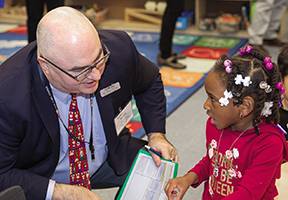
|
Peter Finch is an assistant superintendent in Washington’s West Valley School District, which houses Head Start and community preschools. PHOTO COURTESY OF PETER FINCH
|
Superintendents are more than leaders for their school districts. They are community leaders who unite people around a cause.
Mike Brophy brought this mindset to our work in Yakima, Wash., beginning in 2011 when he became superintendent of the 5,000-student West Valley School District 208. Early on, he brought a relentless focus on collaboration with community partners to strengthen staff and partner knowledge of early learning.
At his first meeting with our six elementary school principals, Brophy established his priorities when he organized a videoconference so the school leaders could learn from expert early learning practitioners. He followed up with professional development for school and district leaders where we learned that investments in early learning produce some of the best returns on investment in education.
We collaborated with early learning providers in Yakima to align curriculum, instruction and assessment. We also shared professional development opportunities and coordinated family engagement strategies with our early learning partners.
A Cohort Contributor
After several years, our reforms brought success. We were invited to a P-3 Education Symposium as keynote speakers where Brophy would deliver introductory remarks that revealed to our peers the truth about our background.
“We are two former high school teachers, two former high school coaches, two former high school principals,” he announced. “If we can do this, you can do this!”
My own learning journey led me to the AASA Early Learning cohort, a network of educational leaders from across the nation. As a cohort member, I’ve had a chance to examine different strategies for early learning in three districts — in Wichita Falls, Texas; Ann Arbor, Mich.; and our own.
Bridges and Mindsets
Superintendents play a unique leadership role when it comes to forging relationships between the district and community providers.
Cohort member Mike Kuhrt, who leads the 14,000-student Wichita Falls district about 150 miles north of Dallas,
recognizes as a superintendent he must use his leadership skills to build bridges among various public agencies and non-profit organizations serving young children and their families. He organized a community summit to assemble all groups addressing health, wellness and child development from birth to age 8 to “support collaboration to align best practices for early learning in the community, the home and the classroom.”
Kuhrt also aligned the Wichita Falls district budget to fund multiple strategies for early learning. The Parents as Teachers program supports families with young children from birth until school entry. Local, state and federal funds support preschool options for families at nearly all of the district’s 16 elementary schools.
In addition, a local foundation supports a partnership with the nonprofit
Waterford.org organization to provide the online UPSTART program in the year prior to kindergarten for every child in the community who is not enrolled in an onsite preschool class. UPSTART concentrates on foundational academic skills for kindergarten readiness.
In challenging mindsets, Kuhrt has moved his district away from the reactive and remedial.
An Equity Issue
In Ann Arbor, Mich., school system leaders have taken the view that access to high-quality preschool should not be left to chance. Every child deserves early childhood experiences that set them on a path for success, says Dawn Linden, Ann Arbor’s assistant superintendent for teaching and learning and a member of the AASA Early Learning cohort.
Ann Arbor has addressed access to preschool by starting a preschool and family center and by adding preschool programs at four elementary schools. Preschool teachers are signed to a regular teacher’s contract because, Linden says, “We know that high-quality teaching and learning starts with top talent.”
The district emphasizes play-based learning and small-group instruction as developmentally appropriate experiences for young children. Activities that build executive function and the social-emotional foundations for learning are the basis for academic progress in the early grades.
My understanding of best practices and equity grew from a fascinating site visit to Ann Arbor with other members of the AASA Early Learning cohort. We visited classrooms and reflected on the degree to which all children were provided access to develop-mentally appropriate practices. We reviewed research presented by Nell Duke, a professor from the University of Michigan, and analyzed research-based practices identified in the
literacyessentials.org materials.
Inconsistencies in instructional practices may be due to implicit biases, such as the view some children need to be controlled while other students can be provided voice and choice. All students need decision-making opportunities, such as choosing activities during play-based time, to develop their executive function.
 |
| Dawn Linden, an assistant superintendent in Ann Arbor, Mich., has helped her district add preschool programs at four elementary schools. PHOTO COURTESY OF DAWN LINDEN |
Beyond Coordination
Superintendents and senior leadership set the direction of engagement and manage collaboration between staff and external partners.
In West Valley, our goals for engagement are to ensure children enter school kindergarten-ready and to align effective practices from preschool through 3rd grade. Workshops, visiting programs and quarterly evening family conferences with breakout sessions for teachers and families help us meet these goals.
The purpose of the family engagement conferences is to listen. Our teachers want to learn about their students and their families so they can provide culturally responsive teaching and personalized learning. Families express interest in topics, and we add strands for those.
We don’t just coordinate activities with community agencies. We have learned to collaborate. Our early learning partners have taught us about effective family engagement practices. We have learned to braid funding to ensure our allocation of resources is aligned with our priorities. From our partners at Central Washington Child Care Aware, we learned that “play and learn” groups for infants and toddlers could be hosted at our elementary schools. This makes our schools more “family-friendly” and the weekly groups provide parents of young children with chances to build a social connection with others.
Early learning providers and kindergarten teachers now meet three times a year for professional dialogue about curriculum, instruction, assessment and family engagement. As a result, we have seen greater alignment of instructional practices among our community partners and our classrooms.
Home visiting programs for preschoolers also yield results. As a result, the district has hired paraeducators to serve as home visitors for school-age children. Based on the success of family engagement conferences for kindergarten families, we have implemented family engagement conferences for all families in the school district — at all schools and all grade levels — during our first week of school.
Planning and coordinating activities fall to our family engagement coordinator, who takes a strength-based approach that listens for family needs and then delivers programs meeting those needs. The work is guided by a P-3 leadership team that includes community partners and school staff. This group identifies the topics for our pre-K workshops.
National Connections
With growing awareness of the positive impact of early learning, a national consensus is forming. Investments in early learning result in better life outcomes.
Superintendents support this work by “telling their story.” Program evaluation is essential to the telling. Our work in West Valley attracted local news media attention when we reported kindergarten readiness had increased from 63 percent of students to 75 percent of students in the district while the state average increased from 61 percent of students to 66 percent of students over the same three-year period.
To build national advocacy, superintendents must share their local stories with state and national leaders.
Edward Manuszak, superintendent in Dundee, Mich., and co-chair of the Early Learning cohort, points to the importance of national leadership recognizing the interdependence of districts and local agencies. “This creates an ecosystem that promotes the launch of new programs, activities and initiatives around the nation,” Manuszak says. AASA has
produced three case studies on early learning that detail how local leaders have approached this work in their communities.
A Broader View
Over the past 10 years, my perspective about educational leadership has changed. Where previously I focused my attention on the K-12 system, now I devote time to connect with community agencies that support children before they enter our school system. I’ve moved from school leadership to educational leadership. I have learned to value collaboration with my community’s early learning providers to maximize the potential of each child who enters the West Valley schools.
As Linden put it during one of cohort sessions, “If we say we care about children in America, it’s time we understand that early childhood matters most!”
PETER FINCH is assistant superintendent of West Valley School District in Yakima, Wash., and co-chair of the AASA Early Learning cohort. Twitter:
@suptfinch
Additional Resources
»AASA Early Learning Cohort. Education leaders from across the country gather to review emerging research on early learning practices and to facilitate program change.
»Literacy Essentials. Learning modules and downloadable PDFs on research-applied practices in literacy, developed by the Early Learning Task Force of the Michigan Association of Intermediate School Administrators.
»National Association for the Education of Young Children. Informational resources on developmentally appropriate topics and equity. Recent books include
Anti-Bias Education for Young Children and Ourselves by Louise Derman-Sparks et al. and
From Children’s Interests to Children’s Thinking: Using a Cycle of inquiry to Plan Curriculum by Jane Tingle Broderick and Seong Bock Hong.